Weather-Based Predictive Modeling of Cercospora beticola Infection Events in Sugar Beet in Belgium
Abstract
1. Introduction
2. Materials and Methods
2.1. Study Sites and Disease Monitoring
2.2. Weather Data
2.3. Predictive Model Development
2.3.1. Determination of Weather Conditions Conducive to Infection by Cercospora beticola
2.3.2. Determination of Daily Infections of Sugar Beet by C. beticola and Calculation of Latency Periods
2.3.3. Model Testing and Validation
2.4. Model Performance Evaluation
3. Results
3.1. Incidence of Cercospora Leaf Spot during the Study Period
3.2. Weather Conditions during the Critical Infection Period of Sugar Beet by Cercospora beticola
3.3. Weather Conditions Conducive to Infection by Cercospora beticola
3.4. Performance of Weather-Based Models during the Testing Phase
3.5. Performance of the Most Accurate Models
4. Discussion
5. Conclusions
Supplementary Materials
Author Contributions
Funding
Institutional Review Board Statement
Informed Consent Statement
Data Availability Statement
Acknowledgments
Conflicts of Interest
References
- Shane, W.W.; Teng, P.S. Impact of Cercospora leaf spot on root weight, sugar yield, and purity of Beta vulgaris. Plant Dis. 1992, 76, 812–820. [Google Scholar] [CrossRef]
- Asher, M.J.C.; Holtschulte, B.; Molard, M.R.; Rosso, F.; Steinrücken, G.; Beckers, R. Cercospora beticola Sacc. Biology, Agronomic Influence and Control. Measures in Sugar Beet; International Institute for Beet Research: Brussels, Belgium, 2000; p. 215. [Google Scholar]
- Weiland, J.; Koch, G. Sugarbeet leaf spot disease (Cercospora beticola Sacc.). Mol. Plant Pathol. 2004, 5, 157–166. [Google Scholar] [CrossRef]
- Vereijssen, J.; Schneider, J.H.M.; Termorshuizen, A.J. Root infection of sugar beet by Cercospora beticola in a climate chamber and in the field. Eur. J. Plant Pathol. 2005, 112, 201–210. [Google Scholar] [CrossRef]
- Lartey, R.T.; Weiland, J.J.; Panella, L.; Crous, P.W.; Windels, C.E. Cercospora Leaf Spot of Sugar Beet and Related Species; The American Phytopathological Society: St. Paul, MN, USA, 2010. [Google Scholar]
- Secor, G.A.; Rivera, V.V.; Khan, M.F.R.; Gudmestad, N.C. Monitoring fungicide sensitivity of Cercospora beticola of sugar beet for disease management decisions. Plant Dis. 2010, 94, 1272–1282. [Google Scholar] [CrossRef]
- Skaracis, G.N.; Biancardi, E. Breeding for Cercospora resistance in sugar beet. In Advances in Sugar Beet Research Volume 2: Cercospora beticola Sacc. Biology, Agronomic Influence and Control Measures in Sugar Beet; Asher, M.J.C., Holtschulte, B., Richard Molard, M., Rosso, F., Steinruecken, G., Beckers, R., Eds.; International Institute for Beet Research: Brussels, Belgium, 2000; pp. 177–195. [Google Scholar]
- Wolf, P.F.J.; Verreet, J.A. An integrated pest management system in Germany for the control of fungal leaf diseases in sugar beet: The IPM sugar beet model. Plant Dis. 2002, 86, 336–344. [Google Scholar] [CrossRef] [PubMed]
- Richerzhagen, D.; Racca, P.; Zeuner, T.; Kuhn, C.; Falke, K.; Kleinhenz, B.; Hau, B. Impact of climate change on the temporal and regional occurrence of Cercospora leaf spot in Lower Saxony. J. Plant Dis. Prot. 2011, 118, 168–177. [Google Scholar]
- Götze, P.; Rücknagel, J.; Wensch-Dorendorf, M.; Märländer, B.; Christen, O. Crop rotation effects on yield, technological quality and yield stability of sugar beet after 45 trial years. Eur. J. Agron. 2017, 82, 50–59. [Google Scholar] [CrossRef]
- Shane, W.; Teng, P. Epidemiology of Cercospora leaf spot. 1981 Sugarbeet Res. Ext. Rep. 1982, 13, 201–213. [Google Scholar]
- Rangel, L.I.; Spanner, R.E.; Ebert, M.K.; Pethybridge, S.J.; Stukenbrock, E.H.; de Jonge, R.; Secor, G.A.; Bolton, M.D. Cercospora beticola: The intoxicating lifestyle of the leaf spot pathogen of sugar beet. Mol. Plant Pathol. 2020, 21, 1020–1041. [Google Scholar] [CrossRef]
- Skaracis, G.N.; Pavli, O.I.; Biancardi, E. Cercospora leaf spot disease of sugar beet. Sugar Tech. 2010, 12, 220–228. [Google Scholar] [CrossRef]
- Vereijssen, J.; Schneider, J.H.M.; Jeger, M.J. Epidemiology of Cercospora leaf spot on sugar beet: Modeling disease dynamics within and between individual plants. Phytopathology 2007, 97, 1550–1557. [Google Scholar] [CrossRef]
- Khan, J.; del Río, L.E.; Nelson, R.; Khan, M.F.R. Improving the Cercospora leaf spot management model for sugar beet in Minnesota and North Dakota. Plant Dis. 2007, 91, 1105–1108. [Google Scholar] [CrossRef] [PubMed]
- Knight, N.L.; Koenick, L.B.; Sharma, S.; Pethybridge, S.J. Detection of Cercospora beticola and Phoma betae on table beet seed using quantitative PCR. Phytopathology 2020, 110, 943–951. [Google Scholar] [CrossRef] [PubMed]
- Solel, Z.; Minz, G. Infection process of Cercospora beticola in sugar beet in relation to susceptibility. Phytopathology 1972, 61, 463–466. [Google Scholar] [CrossRef]
- Windels, C.E.; Lamey, H.A.; Hilde, D.; Widner, J.; Knudsen, T. A Cerospora leaf spot model for sugar beet: In practice by an industry. Plant Dis. 1998, 82, 716–726. [Google Scholar] [CrossRef]
- Rees, R.W.; Flood, J.; Hasan, Y.; Cooper, R.M. Effects of inoculum potential, shading and soil temperature on root infection of oil palm seedlings by the basal stem rot pathogen Ganoderma boninense. Plant Pathol. 2007, 56, 862–870. [Google Scholar] [CrossRef]
- Jacobsen, B.J.; Franc, G.D. Cercospora leaf spot. In Compendium of Beet Diseases and Pests, 2nd ed.; Harveson, R.M., Hanson, L.E., Hein, G.L., Eds.; The American Phytopathological Society: St. Paul, MN, USA, 2009; pp. 7–10. [Google Scholar]
- European Commission. Sugar. Available online: https://ec.europa.eu/info/food-farming-fisheries/plants-and-plant-products/plant-products/sugar_en (accessed on 16 July 2021).
- Koch, H.-J.; Trimpler, K.; Jacobs, A.; Stockfisch, N. Crop rotational effects on yield formation in current sugar beet production–results from a farm survey and field trials. Front. Plant Sci. 2018, 9, 231. [Google Scholar] [CrossRef]
- European Commission. EU Sugar Quota System Comes to an End; European Commission-Press Release: Brussels, Belgium, 2017; Available online: https://ec.europa.eu/commission/presscorner/detail/en/IP_17_3487 (accessed on 16 July 2021).
- European Commission. The End of the Sugar Production Quotas in the EU; European Commission-Press Release: Brussels, Belgium, 2017; Available online: https://ec.europa.eu/commission/presscorner/detail/en/MEMO_17_3488 (accessed on 16 July 2021).
- Shane, W.; Teng, P. Cercospora beticola infection prediction model. 1983 Sugarbeet Res. Ext. Rep. 1984, 14, 174–179. [Google Scholar]
- Rossi, V.; Battilani, P. Cercopri: A forecasting model for primary infections of Cercospora leaf spot of sugarbeet. EPPO Bull. 1991, 21, 527–531. [Google Scholar] [CrossRef]
- Rossi, V.; Racca, P.; Battilani, P. A simulation model for Cercospora leaf spot epidemics on sugarbeet. Phytopathol. Mediterr. 1994, 33, 105–112. [Google Scholar]
- Racca, P.; Jörg, E. CERCBET 3–a forecaster for epidemic development of Cercospora beticola. EPPO Bull. 2007, 37, 344–349. [Google Scholar] [CrossRef]
- Shane, W.; Teng, P. Evaluation and implementation of the Cercospora leaf spot prediction model. 1984 Sugarbeet Res. Ext. Rep. 1985, 15, 129–138. [Google Scholar]
- IRBAB. Variétés de Betterave Recommandées par l’IRBAB en 2018; Institut Royal Belge pour l’Amélioration de la Betterave (IRBAB): Tienen, Belgium, 2018; Available online: https://www.irbab-kbivb.be/wp-content/uploads/2017/12/fiche_varietes_2018.pdf (accessed on 16 July 2021).
- Horsfall, J.G.; Barratt, R.W. An improved grading system for measuring plant disease. (Abstr.). Phytopathology 1945, 35, 655. [Google Scholar]
- Institut Royal Belge pour l’Amélioration de la Betterave. Protocole Pour L’expérimentation Variétale en Vue de L’inscription de Nouvelles Variétés de Betteraves Sucrières au Catalogue Belge, Valable Pour les Nouvelles Demandes Faites à Partir de 2012; Institut Royal Belge pour l’Amélioration de la Betterave (IRBAB): Tienen, Belgium, 2012; Available online: https://lv.vlaanderen.be/sites/default/files/attachments/Protocole%20betteraves%201-2012.pdf (accessed on 16 July 2021).
- Doutreloup, S.; Kittel, C.; Wyard, C.; Belleflamme, A.; Amory, C.; Erpicum, M.; Fettweis, X. Precipitation evolution over Belgium by 2100 and sensitivity to convective schemes using the regional climate model MAR. Atmosphere 2019, 10, 321. [Google Scholar] [CrossRef]
- Doutreloup, S.; Wyard, C.; Amory, C.; Kittel, C.; Erpicum, M.; Fettweis, X. Sensitivity to convective schemes on precipitation simulated by the regional climate model MAR over Belgium (1987–2017). Atmosphere 2019, 10, 34. [Google Scholar] [CrossRef]
- El Jarroudi, M.; Kouadio, L.; Delfosse, P.; Tychon, B. Brown rust disease control in winter wheat: I. Exploring an approach for disease progression based on night weather conditions. Environ. Sci. Pollut. Res. 2014, 21, 4797–4808. [Google Scholar] [CrossRef]
- Pethybridge, S.J.; Sharma, S.; Hansen, Z.; Kikkert, J.R.; Olmstead, D.L.; Hanson, L.E. Optimizing Cercospora leaf spot control in table beet using action thresholds and disease forecasting. Plant Dis. 2020, 104, 1831–1840. [Google Scholar] [CrossRef]
- Bleiholder, H.; Weltzien, H. Beiträge zur Epidemiologie von Cercospora beticola Sacc. an Zuckerrübe: I. Die Inkubations-und die Fruktifikationszeit. J. Phytopathol. 1971, 72, 344–353. [Google Scholar] [CrossRef]
- Bleiholder, H.; Weltzien, H.C. Beitrage zur epidemiologie von Cercospopa beticola Sacc. an zuckerrube. II: Die Konidienbildung in Abhängigkeit von den Umweltbedingungen Temperatur, relative Luftfeuchtigkeit und Licht. J. Phytopathol. 1972, 73, 46–68. [Google Scholar] [CrossRef]
- Kassambara, A.; Mundt, F. Factoextra: Extract and Visualize the Results of Multivariate Data Analyses. R Package Version 1.0.7. Available online: https://CRAN.R-project.org/package=factoextra (accessed on 16 July 2021).
- R Core Team. R: A Language and Environment for Statistical Computing; R Foundation for Statistical Computing: Vienna, Austria, 2020. [Google Scholar]
- El Jarroudi, M.; Delfosse, P.; Maraite, H.; Hoffmann, L.; Tychon, B. Assessing the accuracy of simulation model for Septoria leaf blotch disease progress on winter wheat. Plant Dis. 2009, 93, 983–992. [Google Scholar] [CrossRef]
- Crown, M.D. Validation of the NOAA Space Weather Prediction Center’s solar flare forecasting look-up table and forecaster-issued probabilities. Space Weather 2012, 10. [Google Scholar] [CrossRef]
- ESRI. ArcGIS Desktop: Release 10, Technical Report; Environmental Systems Research Institute (ESRI): Redlands, CA, USA, 2016. [Google Scholar]
- Holtschulte, B. Cercospora beticola—worldwide distribution and incidence. In Advances in Sugar Beet Research Volume 2: Cercospora beticola Sacc. Biology, Agronomic Influence and Control Measures in Sugar Beet; Asher, M.J.C., Holtschulte, B., Richard Molard, M., Rosso, F., Steinruecken, G., Beckers, R., Eds.; International Institute for Beet Research: Brussels, Belgium, 2000; pp. 5–16. [Google Scholar]
- El Jarroudi, M.; Kouadio, L.; Giraud, F.; Delfosse, P.; Tychon, B. Brown rust disease control in winter wheat: II. Exploring the optimization of fungicide sprays through a decision support system. Environ. Sci. Pollut. Res. 2014, 21, 4809–4818. [Google Scholar] [CrossRef][Green Version]
- El Jarroudi, M.; Kouadio, L.; Beyer, M.; Junk, J.; Hoffmann, L.; Tychon, B.; Maraite, H.; Bock, C.H.; Delfosse, P. Economics of a decision–support system for managing the main fungal diseases of winter wheat in the Grand-Duchy of Luxembourg. Field Crops Res. 2015, 172, 32–41. [Google Scholar] [CrossRef]
- Wolf, P.F.J.; Verreet, J.A. Möglichkeiten und grenzen der prognose von pilzlichen blattkrankheiten der zuckerrübe. Mitt. Bio. Bund.-Anst. Land-und Forstwirtsch. 2000, 376, 203–204. [Google Scholar]
- Hoffmann, C.M. Importance of canopy closure and dry matter partitioning for yield formation of sugar beet varieties. Field Crops Res. 2019, 236, 75–84. [Google Scholar] [CrossRef]
- Vandendriessche, H.J.; van Ittersum, M.K. Crop models and decision support systems for yield forecasting and management of the sugar beet crop. Eur. J. Agron. 1995, 4, 269–279. [Google Scholar] [CrossRef]


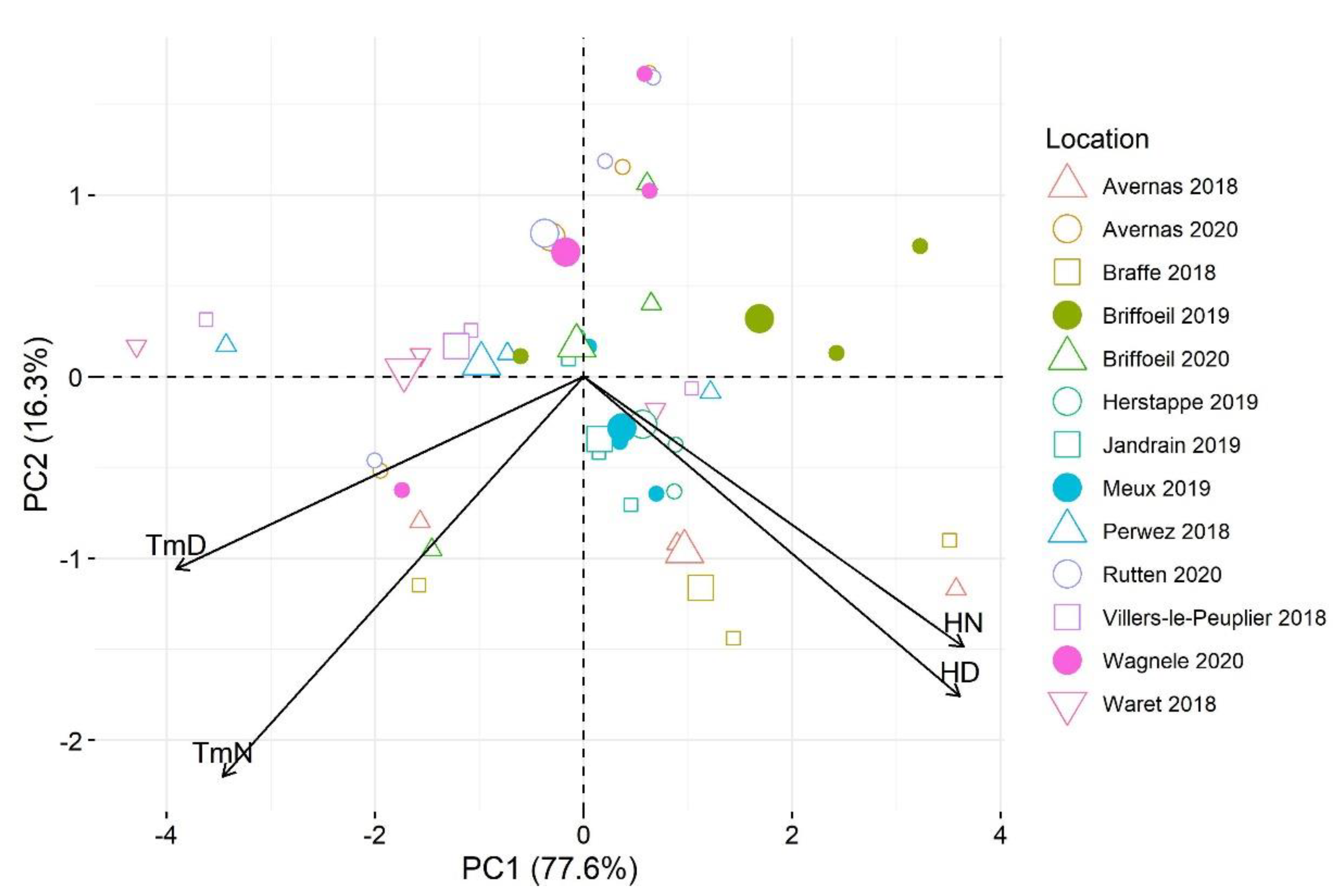
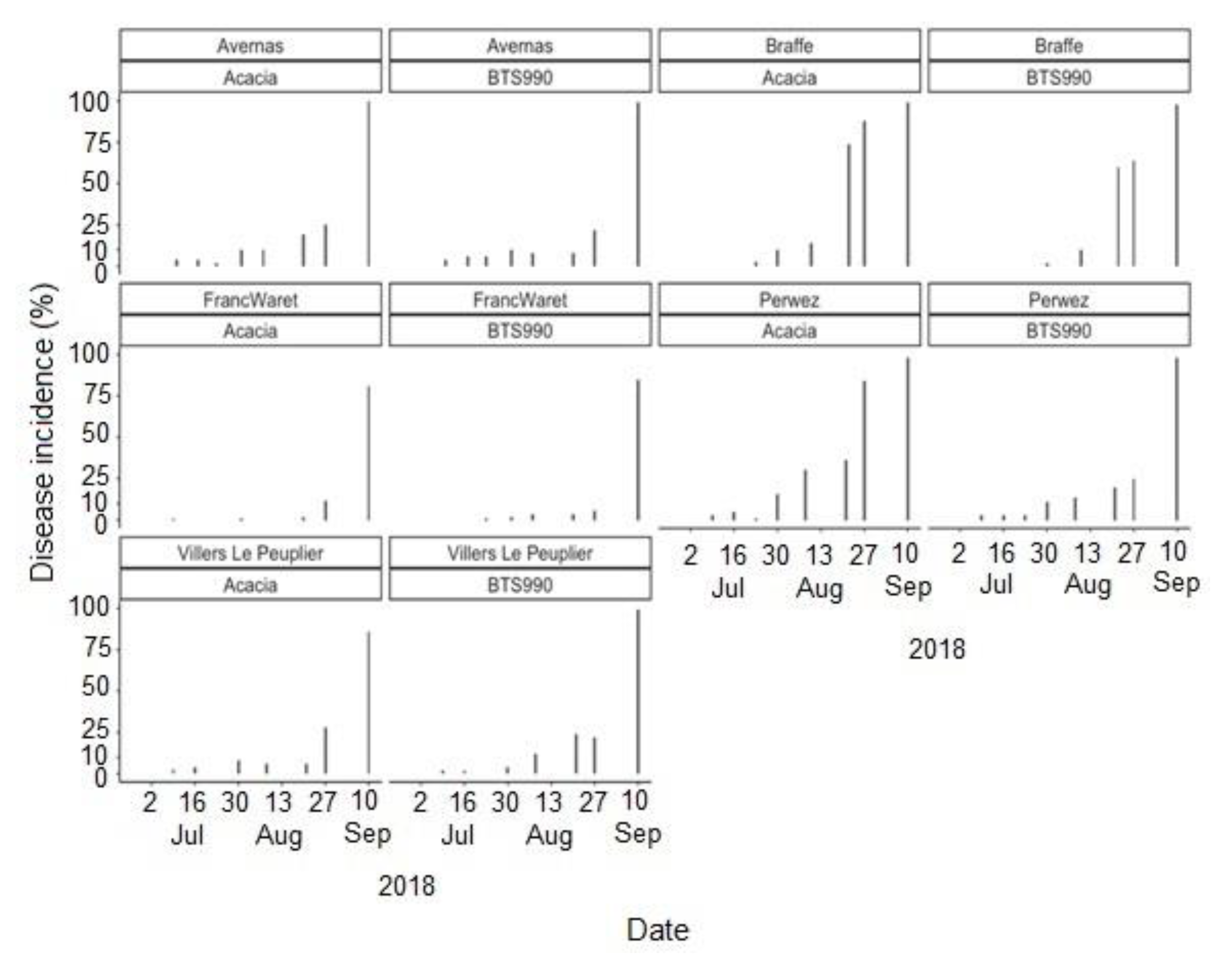
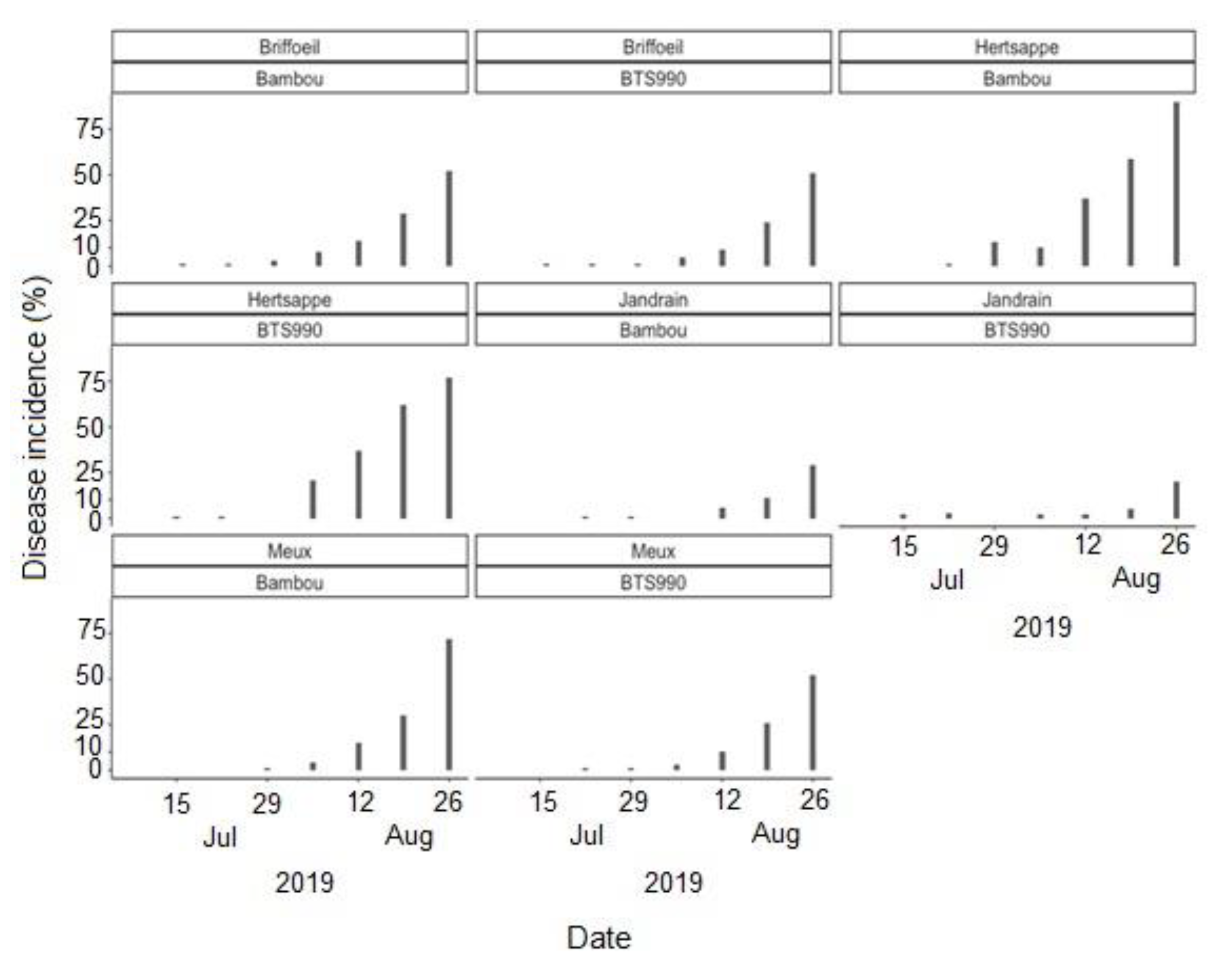
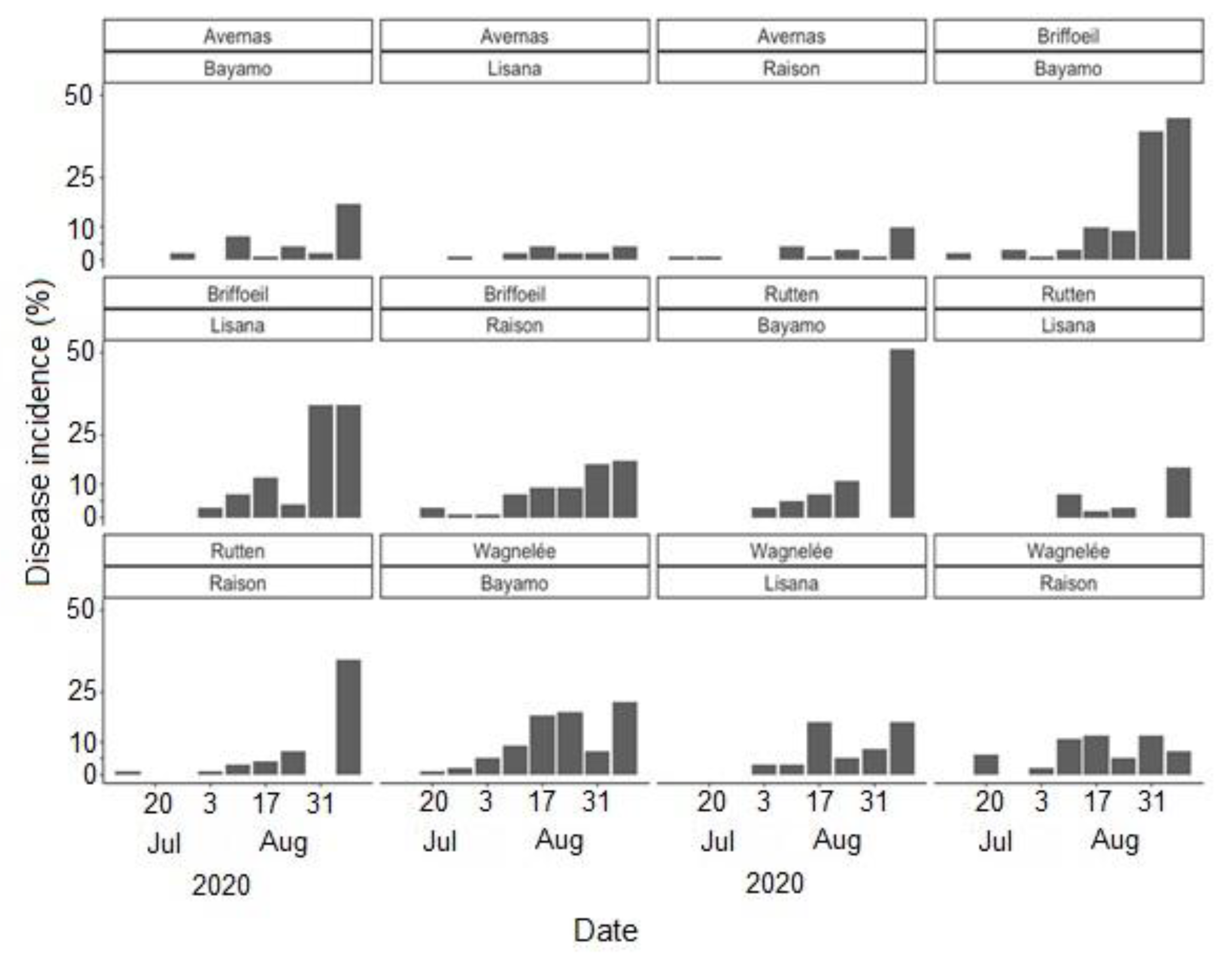
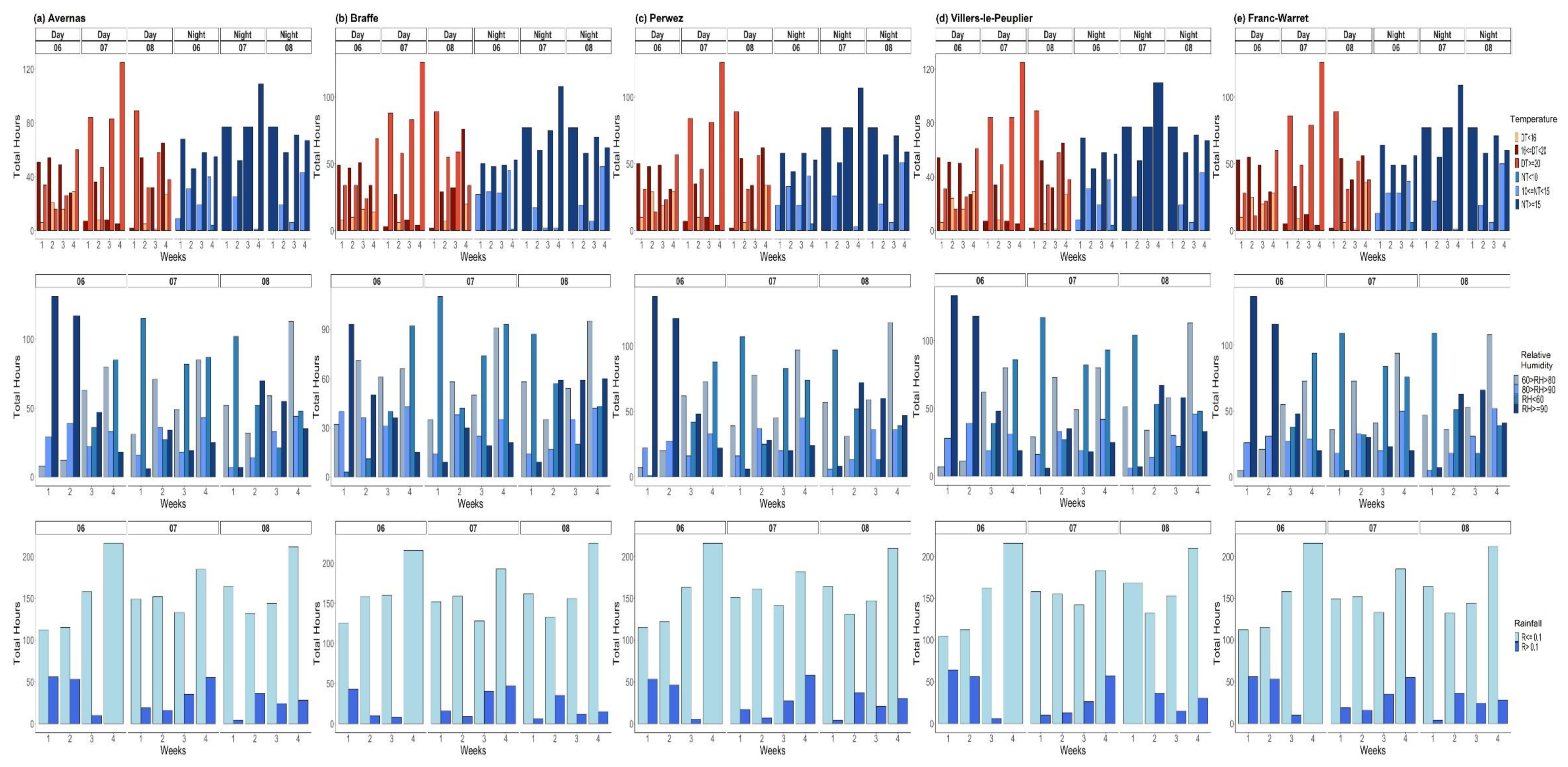
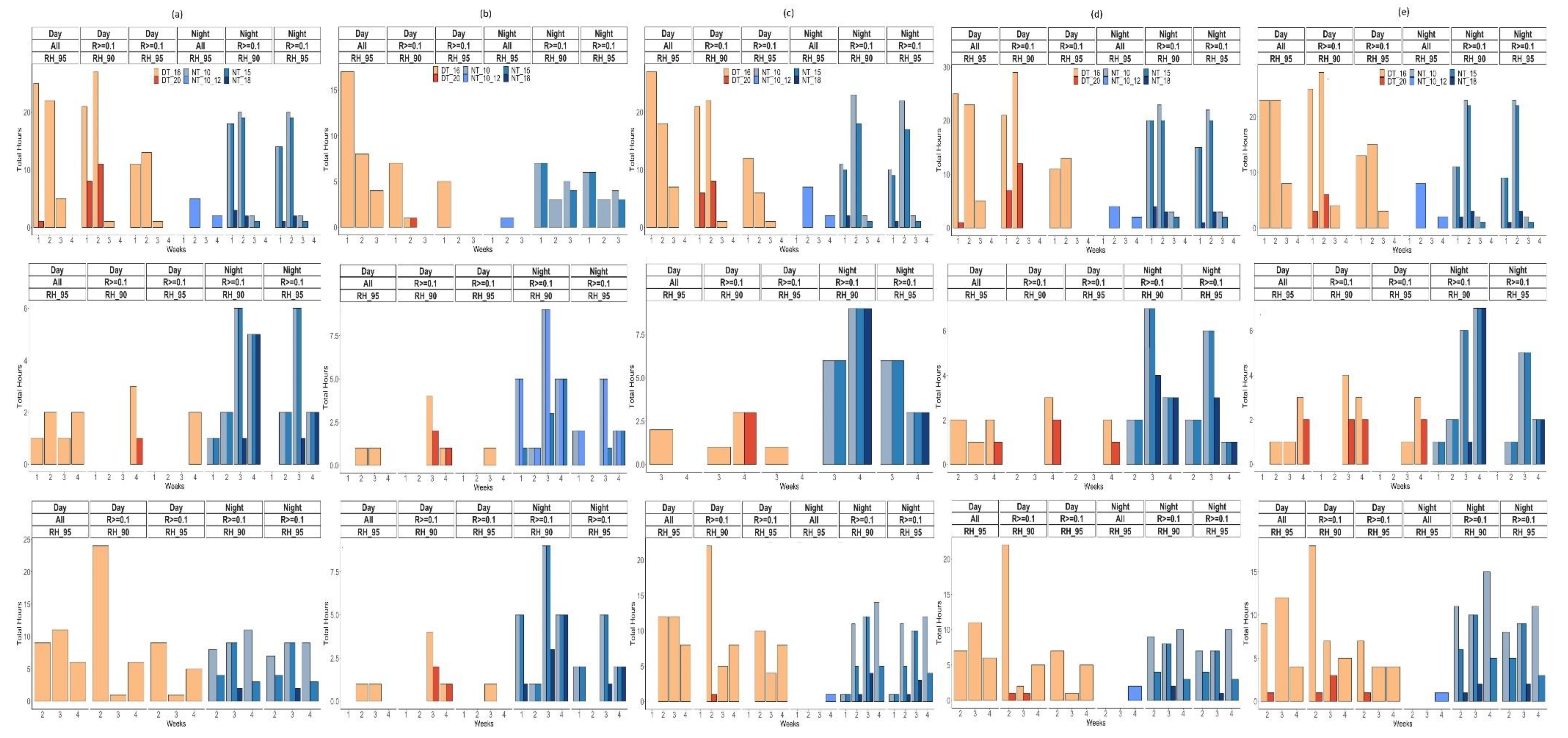

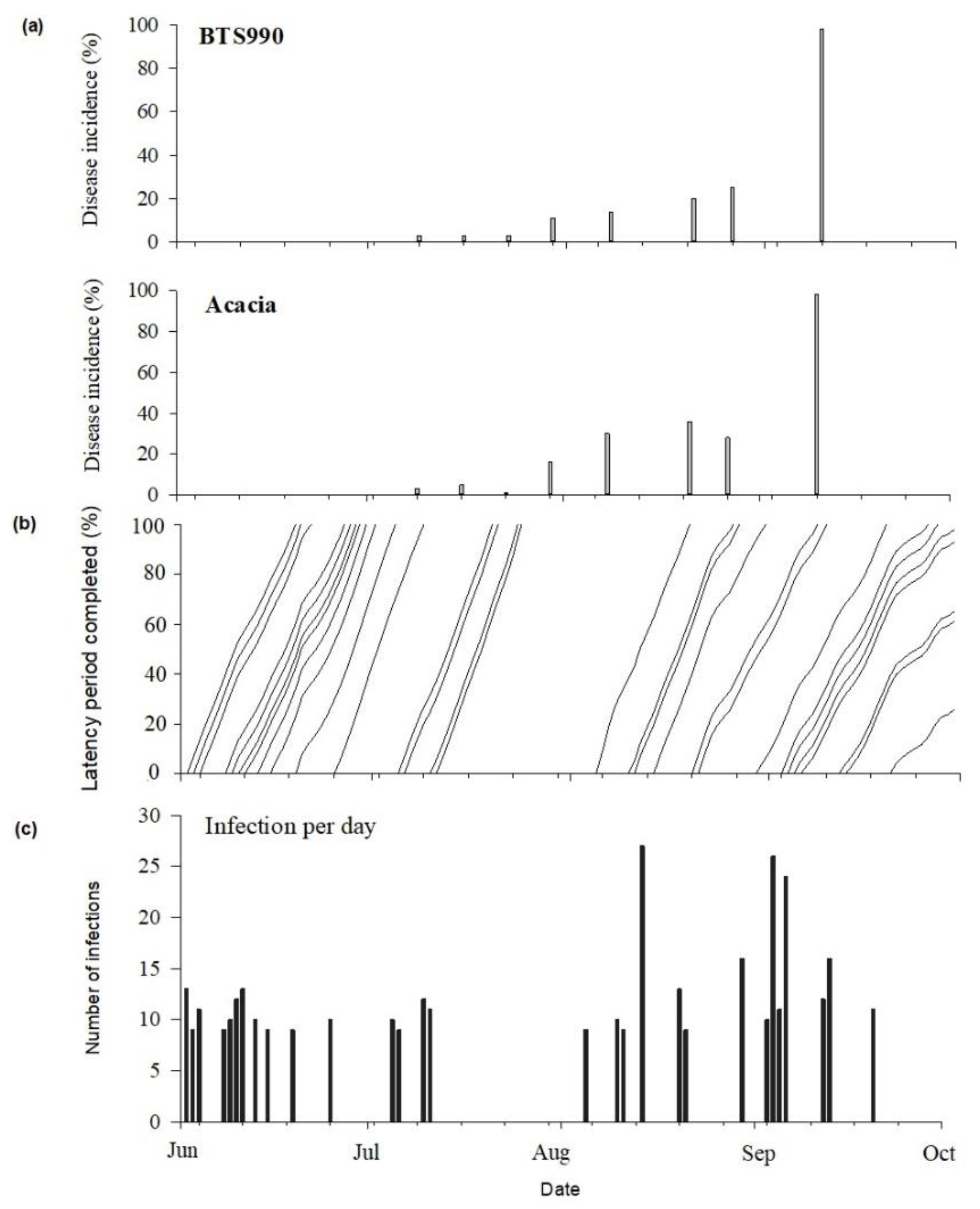
| Year | Site | Cultivar | Sowing Date | Disease Susceptibility a |
|---|---|---|---|---|
| 2018 | Avernas | BTS990 | 7 April 2018 | 6 |
| Acacia | 4 | |||
| Braffe | BTS990 | 18 April 2018 | 6 | |
| Acacia | 4 | |||
| Franc-Waret | BTS990 | 16 April 2018 | 6 | |
| Acacia | 4 | |||
| Villers-le-Peuplier | BTS990 | 6 April 2018 | 6 | |
| Acacia | 4 | |||
| Perwez | BTS990 | 14 April 2018 | 6 | |
| Acacia | 4 | |||
| 2019 | Briffoeil | BTS990 | 6 April 2019 | 6 |
| Bambou | 5 | |||
| Lisanna | 7 | |||
| Herstappe | BTS990 | 29 March 2019 | 6 | |
| Bambou | 5 | |||
| Lisanna | 7 | |||
| Jandrain | BTS990 | 6 April 2019 | 6 | |
| Bambou | 5 | |||
| Lisanna | 7 | |||
| Meux | BTS990 | 31 March 2019 | 6 | |
| Bambou | 5 | |||
| Lisanna | 7 | |||
| 2020 | Avernas | Bayamo | 31 March 2020 | 5 |
| Lisanna | 7 | |||
| Raison | 6 | |||
| Briffoeil | Bayamo | 31 March 2020 | 5 | |
| Lisanna | 7 | |||
| Raison | 6 | |||
| Rutten | Bayamo | 4 April 2020 | 5 | |
| Lisanna | 7 | |||
| Raison | 6 | |||
| Wagnelée | Bayamo | 1 April 2020 | 5 | |
| Lisanna | 7 | |||
| Raison | 6 |
| Variable | Intervals | |||
|---|---|---|---|---|
| Rainfall (mm) | R < 0.1 | R ≥ 0.1 | ||
| Relative humidity (%) | RH < 60 | 60 ≤ RH < 80 | 80 ≤ RH < 90 | RH ≥ 90 |
| Daytime Temperature (°C) | T < 16 | 16 ≤ T < 20 | T ≥ 20 | |
| Nighttime Temperature (°C) | T < 10 | 10 ≤ T < 15 | T ≥ 15 |
| Testing | Validation |
|---|---|
| Avernas 2018 | Braffe 2018 |
| Franc-Waret 2018 | Perwez 2018 |
| Villers-le-Peuplier 2018 | Briffoeil 2019 |
| Herstappe 2019 | Jandrain 2019 |
| Meux 2019 | Avernas 2020 |
| Briffoeil 2020 | |
| Wagnelée 2020 | |
| Rutten 2020 |
| Model | Hourly Rainfall (R) | Hourly Relative Humidity (RH) | Hourly Temperature (T; °C) | |
|---|---|---|---|---|
| Nighttime | Daytime | |||
| M1 | R ≥ 0.1 mm during the 4 preceding hours | RH > 90% during the first 4 h, then >60% during the following 9 h | T > 10 | T > 16 |
| M2 | T > 15 | T > 16 | ||
| M3 | T > 18 | T > 16 | ||
| M4 | R ≥ 0.1 mm during the 4 preceding hours | RH > 95% during the first 4 h, then >60% during the following 9 h | T > 10 | T > 16 |
| M5 | T > 15 | T > 16 | ||
| M6 | T > 18 | T > 16 | ||
| M7 | R ≥ 0.1 mm during the 4 preceding hours | RH > 90% during the first 4 h, then >60% during the following 9 h | T > 10 | T > 20 |
| M8 | T > 15 | T > 20 | ||
| M9 | T > 18 | T > 20 | ||
| M10 | R ≥ 0.1 mm during the 4 preceding hours | RH > 95% during the first 4 h, then >60% during the following 9 h | T > 10 | T > 20 |
| M11 | T > 15 | T > 20 | ||
| M12 | T > 18 | T > 20 | ||
| M13 | No specific rainfall condition required | RH > 95% during the first 4 h, then >60% during the following 9 h | 10< T < 12 | T > 16 |
| M14 | 10< T < 12 | T > 20 | ||
| M1 | M2 | M3 | M4 | M5 | M6 | M7 | M8 | M9 | M10 | M11 | M12 | M13 | |
|---|---|---|---|---|---|---|---|---|---|---|---|---|---|
| Probability of detection (POD) | |||||||||||||
| Avernas 2018 | 100 | 73 | 80 | 75 | 75 | 75 | 33 | 33 | 33 | 22 | 20 | 20 | 20 |
| Briffoeil 2020 | 100 | 94 | 95 | 88 | 88 | 88 | 72 | 73 | 73 | 36 | 36 | 36 | 38 |
| Herstappe 2019 | 100 | 92 | 92 | 100 | 100 | 100 | 56 | 56 | 56 | 25 | 22 | 22 | 22 |
| Meux 2019 | 100 | 83 | 83 | 50 | 50 | 50 | 44 | 44 | 44 | 29 | 29 | 29 | 25 |
| Wagnéllie 2020 | 100 | 95 | 95 | 54 | 54 | 54 | 69 | 69 | 69 | 36 | 36 | 36 | 22 |
| Waret 2018 | 91 | 82 | 80 | 90 | 73 | 73 | 43 | 38 | 38 | 29 | 29 | 29 | 43 |
| Villers-le-Peuplier 2018 | 100 | 100 | 100 | 75 | 75 | 75 | 46 | 46 | 46 | 22 | 22 | 22 | 22 |
| Rutter 2020 | 100 | 100 | 100 | 29 | 29 | 29 | 91 | 91 | 91 | 14 | 14 | 14 | 0 |
| Mean—All sites | 99 | 90 | 91 | 70 | 68 | 68 | 57 | 56 | 56 | 27 | 26 | 26 | 24 |
| False alarm ratio (FAR) | |||||||||||||
| Avernas 2018 | 14 | 20 | 11 | 0 | 0 | 0 | 0 | 0 | 0 | 0 | 0 | 0 | 0 |
| Briffoeil 2020 | 8 | 10 | 16 | 0 | 0 | 0 | 0 | 0 | 0 | 0 | 0 | 0 | 0 |
| Herstappe 2019 | 14 | 14 | 8 | 0 | 0 | 0 | 17 | 17 | 17 | 0 | 0 | 0 | 0 |
| Meux 2019 | 0 | 0 | 0 | 0 | 0 | 0 | 0 | 0 | 0 | 0 | 0 | 0 | 0 |
| Wagnéllie 2020 | 10 | 10 | 10 | 13 | 13 | 13 | 0 | 0 | 0 | 0 | 0 | 0 | 0 |
| Waret 2018 | 0 | 11 | 11 | 0 | 0 | 11 | 0 | 0 | 0 | 0 | 0 | 0 | 0 |
| Villers-le-Peuplier 2018 | 20 | 20 | 20 | 0 | 0 | 0 | 0 | 0 | 0 | 0 | 0 | 0 | 0 |
| Rutter 2020 | 6 | 6 | 6 | 50 | 50 | 50 | 10 | 10 | 10 | 50 | 50 | 50 | 0 |
| Mean—All sites | 9 | 11 | 10 | 8 | 8 | 9 | 3 | 3 | 3 | 6 | 6 | 6 | 0 |
| Critical success index (CSI) | |||||||||||||
| Avernas 2018 | 86 | 62 | 73 | 75 | 75 | 75 | 33 | 33 | 33 | 22 | 20 | 20 | 20 |
| Briffoeil 2020 | 92 | 85 | 81 | 88 | 88 | 88 | 72 | 73 | 73 | 36 | 36 | 36 | 38 |
| Herstappe 2019 | 86 | 80 | 86 | 60 | 50 | 50 | 50 | 50 | 50 | 25 | 22 | 22 | 22 |
| Meux 2019 | 100 | 83 | 83 | 50 | 50 | 50 | 44 | 44 | 44 | 29 | 29 | 29 | 25 |
| Wagnéllie 2020 | 90 | 86 | 86 | 50 | 50 | 50 | 69 | 69 | 69 | 36 | 36 | 36 | 22 |
| Waret 2018 | 91 | 75 | 73 | 90 | 73 | 67 | 43 | 38 | 38 | 29 | 29 | 29 | 43 |
| Villers-le-Peuplier 2018 | 80 | 80 | 80 | 75 | 75 | 75 | 46 | 46 | 46 | 22 | 22 | 22 | 22 |
| Rutter 2020 | 94 | 94 | 94 | 22 | 22 | 22 | 83 | 83 | 83 | 13 | 13 | 13 | 0 |
| Mean—All sites | 90 | 81 | 82 | 64 | 60 | 60 | 55 | 55 | 55 | 27 | 26 | 26 | 24 |
Publisher’s Note: MDPI stays neutral with regard to jurisdictional claims in published maps and institutional affiliations. |
© 2021 by the authors. Licensee MDPI, Basel, Switzerland. This article is an open access article distributed under the terms and conditions of the Creative Commons Attribution (CC BY) license (https://creativecommons.org/licenses/by/4.0/).
Share and Cite
El Jarroudi, M.; Chairi, F.; Kouadio, L.; Antoons, K.; Sallah, A.-H.M.; Fettweis, X. Weather-Based Predictive Modeling of Cercospora beticola Infection Events in Sugar Beet in Belgium. J. Fungi 2021, 7, 777. https://doi.org/10.3390/jof7090777
El Jarroudi M, Chairi F, Kouadio L, Antoons K, Sallah A-HM, Fettweis X. Weather-Based Predictive Modeling of Cercospora beticola Infection Events in Sugar Beet in Belgium. Journal of Fungi. 2021; 7(9):777. https://doi.org/10.3390/jof7090777
Chicago/Turabian StyleEl Jarroudi, Moussa, Fadia Chairi, Louis Kouadio, Kathleen Antoons, Abdoul-Hamid Mohamed Sallah, and Xavier Fettweis. 2021. "Weather-Based Predictive Modeling of Cercospora beticola Infection Events in Sugar Beet in Belgium" Journal of Fungi 7, no. 9: 777. https://doi.org/10.3390/jof7090777
APA StyleEl Jarroudi, M., Chairi, F., Kouadio, L., Antoons, K., Sallah, A.-H. M., & Fettweis, X. (2021). Weather-Based Predictive Modeling of Cercospora beticola Infection Events in Sugar Beet in Belgium. Journal of Fungi, 7(9), 777. https://doi.org/10.3390/jof7090777






